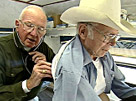
Country Doctors, Rural Medicine 2004
Distributed by Fanlight Productions, 32 Court St., 21st Floor, Brooklyn, NY 11201; 800-876-1710
Produced by Oregon Public Broadcasting
Directed by Eric Cain
VHS, color, 56 min.
College - Adult
Health Sciences, Nursing
Date Entered: 03/25/2005
Reviewed by Charles Burkart, Head, Audiovisual Library, West Virginia University, Morgantown, WVThis superb new documentary, Country Doctors, Rural Medicine from Oregon Public Broadcasting covers all aspects of the incipient crisis in rural health care. Eastern Oregon is an isolated rural area whose economy consists of ranching, farming, and timbering. There is a severe shortage of all health professionals (doctors, dentists, physician assistants and nurses), and the few health professionals there are sometimes have to travel hundreds of miles to see their patients. House calls are common in rural medicine. Moreover, the aging rural population tends to avoid seeing doctors unless seriously ill. This means that rural doctors frequently deal with more serious injuries, such as chain saw accidents and head and chest trauma due to animal kicks. Ambulance rides are also lengthy and many seriously ill patients can be riding for over an hour to reach their destination.
Country Doctors, Rural Medicine examines the problems of rural medicine relevant to all sparsely populated states. Here in rural West Virginia, we are facing the same problem of an aging and increasingly impoverished population. The film offers concrete solutions for these complex problems. State health educators should require a certain number of doctors to complete rural residencies. Medical insurance must be made more affordable and frivolous lawsuits discouraged. Furthermore, the real key to keeping rural doctors seems to be finding gainful, satisfying employment for their spouses. In addition, more preventative medicine is urgently needed to stem unhealthy rural lifestyles.
This is a superbly organized video, which proceeds like a well constructed play. All characters are introduced at the beginning of the film and their interviews are finely woven throughout the whole program. Colors are vivid and editing is well paced. A variety of camera angles keep the film interesting even when shot in dull confined, cramped spaces. Sound is good and participants are easy to understand. Light-hearted humor is introduced on more than one occasion.
The film can’t be recommended highly enough. It is applicable to a large number of rural states that are facing the same health problems. It would be useful in nursing, and health sciences programs at community and four year colleges, as well as medical schools.